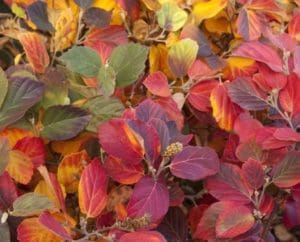A beautiful native shrub that is blooming now is the Fothergilla. This native shrub deserves the spotlight for its fall foliage show, and spring flowers, ease of care, and versatility round out a profile of a beautiful and multipurpose plant. (Did I mention the gorgeous fall color?) These native shrubs are useful as foundation plants, in shrub borders and when massed. Related to witch hazels, they combine well in home landscapes with azaleas and rhododendrons, as well as Japanese andromeda.
There are two species in the genus: Large Fothergilla (F. major) is native to the Allegheny Mountains of the eastern United States, while dwarf Fothergilla (F. gardenii) grows naturally along the Southeastern coastal plain. Both shrubs are very hardy here and are rarely troubled by insects or diseases. Large Fothergilla grows 6 to 8 feet high and wide, while dwarf Fothergilla stays at 3 to 6 feet.
Plant these shrubs in full sun to partial shade, however, they will flower and have better fall color in sun. They grow best in moderately moist but well-drained ground that has a soil pH on the acidic side (what we generally have here). Since it blooms on last year’s growth, prune after the flowering period if you truly need to prune (alternatively, if you do not mind losing a few of next year’s flowers, you can prune when the bush is dormant). But Fothergilla requires only minimal pruning. If branches are rubbing against each other in the inner part of the plant, you may wish to prune to “open up” the shrub. But avoid pruning it to give it a uniform shape: it is more appealing when it sports the “wild look.” You can trim off dead branches at any time of the year.

There are two cultivars that are commonly found, both outstanding plants: Blue Shadow, and Mount Airy. Mount Airy has an upright growth habit and reaches 3 to 5 feet in height, with a similar width. In spring, this shrub is tipped with white flowers (1 to 3 inches long) that have the appearance of little bottlebrushes, which is why “bottlebrush” is another common name for the shrub. The flowers, which bloom in mid- or early spring, smell a bit like licorice. Blue Shadow is a little bigger, 4 – 6’ tall and wide. Its foliage comes in green in spring, turns a beautiful blue/gray in summer, and brilliant shades of yellow, orange and red in fall. It will sometimes shoot out an all green branch – just prune these off so the whole plant doesn’t revert to green.
You won’t regret planting one of these in your garden! Pick one up from your local garden center.
by Liz Nalle, contributor to the Coastal Point Newspaper
